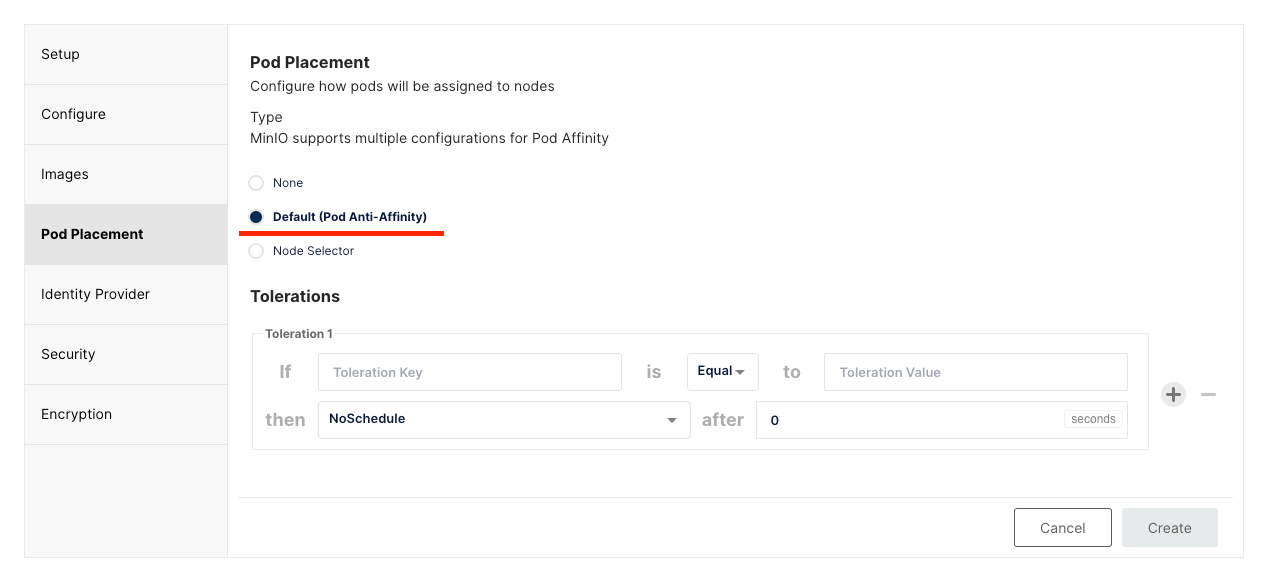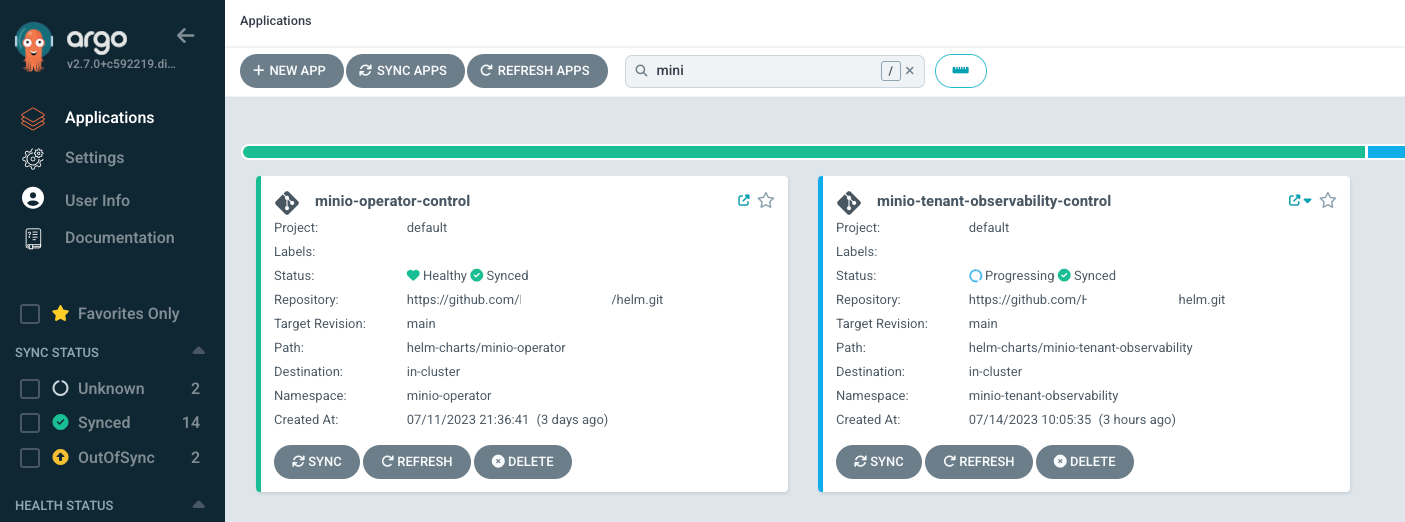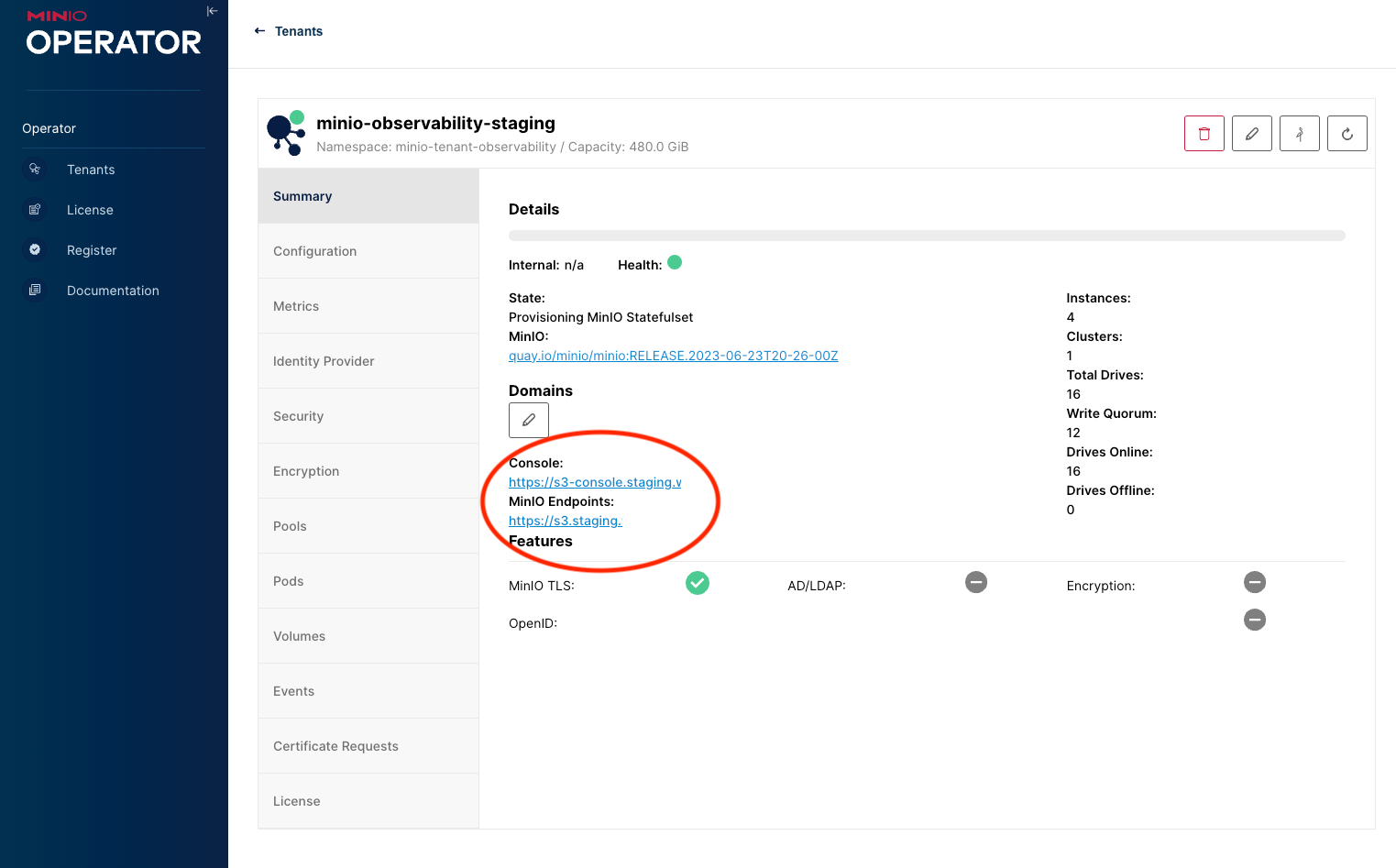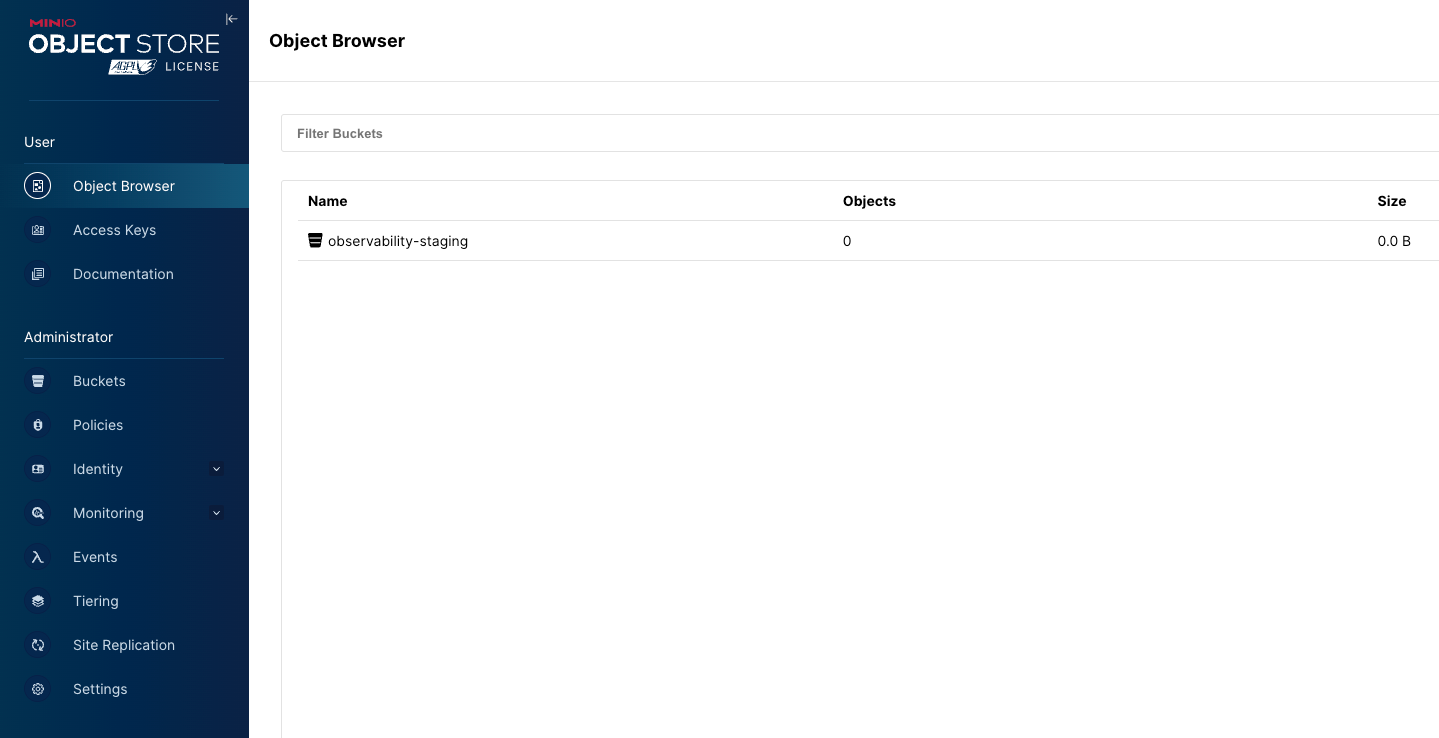In this post I am going to cover deploying a MinIO Tenant, this is the layer that allows the s3 API and buckets to be generated.
If you haven't set up MinIO Operator yet, you can follow Part 1 of this and get all set up, and this post will assume that you have.
Background
So this should be simple, but the documentation while all there is not organized in the greatest way and made things difficult when trying to configure everything.
Basically, I want to deploy a MinIO tenant via helm charts using ArgoCD and not using the k8 MinIO plugin cmd.
The Tenant I want to build will be for long-term storage for my observability stack, there is a few things this post won't cover to make it fully Production Grade and secure e.g. setting up KMS and server-side encryption.
Helm Chart
First, we create a chart and list the MinIOs tenant chart as a dependency.
helm-charts/minio-tenant-observability
apiVersion: v2
name: minio-observability-storage
home: https://min.io
icon: https://min.io/resources/img/logo/MINIO_wordmark.png
version: 0.0.0
appVersion: 0.0.0
type: application
description: A Helm chart for MinIO tenent
dependencies:
- name: tenant
repository: https://operator.min.io/
version: 5.0.6
Pretty simple, next is going to be the values file and this is where it became a little annoying to do and I explain why as I go through:
helm-charts/minio-tenant-observability/staging/values-control.yaml
First part: (will give complete file below)
tenant:
# Tenant name
name: minio-observability-staging
## Secret name that contains additional environment variable configurations.
## The secret is expected to have a key named config.env containing environment variables exports.
configuration:
name: minio-observability-staging-env-configuration
pools:
- servers: 4
name: pool-0
volumesPerServer: 4
## size specifies the capacity per volume
size: 30Gi
## storageClass specifies the storage class name to be used for this pool
storageClassName: ext-nas-storage-class
securityContext:
runAsUser: 100
runAsGroup: 1000
runAsNonRoot: true
fsGroup: 1000
metrics:
enabled: true
port: 9000
protocol: httpconfiguration.namethis is a secret that should be created beforehand and includes a username and password, so should be created in a secure method.poolsthere is a lot of configuration that you can use here and if you have used the MinIO console to create a Tenant and are now trying to replicate it into Helm the main thing to note is, in the console by default the console will use "Default" pod placement, this is fine if you have 4 usable k8 nodes, but in my case I have 2 API nodes and 2 normal nodes. So in the helm values, you need to make sure you do not have anynodeSelectororaffinityconfig otherwise the pods will not start.

3. securityContext this was important for my setup and may not be an issue for you. Our storage server would only allow for files/folders to be written with a user called _apt which for us the UID was 100 so this needed to be updated, otherwise, everything would start but you would have a lot of logs complaining that permission was denied.
The last part has everything to do with exposing the Tenant API and Console and this caused me the most trouble to figure out. As I said the docs are there but not so obvious, I didn't find the docs that I needed on their "how to install" web page, but I found them in the git repo. (I think this a bit better than the web page as well)
features:
bucketDNS: true
domains:
console: https://s3-console.staging.domain.io
minio:
- https://s3.staging.domain.io
buckets:
- name: observability-staging
region: eu-west-1
# Tenant scrape configuration will be added to prometheus managed by the prometheus-operator.
prometheusOperator: true
ingress:
api:
enabled: true
labels: {}
annotations:
cert-manager.io/cluster-issuer: letsencrypt-staging-wpt
kubernetes.io/ingress.class: "nginx"
nginx.ingress.kubernetes.io/backend-protocol: "HTTPS"
nginx.ingress.kubernetes.io/rewrite-target: /
nginx.ingress.kubernetes.io/proxy-body-size: "0"
nginx.ingress.kubernetes.io/server-snippet: |
client_max_body_size 0;
nginx.ingress.kubernetes.io/configuration-snippet: |
chunked_transfer_encoding off;
tls:
- secretName: minio-tenant-observability-general-tls
hosts:
- s3.staging.domain.io
host: s3.staging.domain.io
path: /
pathType: Prefix
console:
enabled: true
labels: {}
annotations:
cert-manager.io/cluster-issuer: letsencrypt-staging-wpt
kubernetes.io/ingress.class: "nginx"
nginx.ingress.kubernetes.io/backend-protocol: "HTTPS"
nginx.ingress.kubernetes.io/rewrite-target: /
nginx.ingress.kubernetes.io/proxy-body-size: "0"
nginx.ingress.kubernetes.io/server-snippet: |
client_max_body_size 0;
nginx.ingress.kubernetes.io/configuration-snippet: |
chunked_transfer_encoding off;
tls:
- secretName: minio-tenant-observability-con-general-tls
hosts:
- s3-console.staging.domain.io
host: s3-console.staging.domain.io
path: /
pathType: Prefixfeatures.doaminsthis is really important, if you do not define these and still define the ingress later nothing will work. This tells the MinIO app to expect and use these domains for requests. Otherwise, it will only work locally in the cluster.ingress.api.annotationsandingress.console.annotationshere was my pain point. For ingress to work this is the most important part. If you do not have
nginx.ingress.kubernetes.io/backend-protocol: "HTTPS" nginx.ingress.kubernetes.io/rewrite-target: / nginx.ingress.kubernetes.io/proxy-body-size: "0" nginx.ingress.kubernetes.io/server-snippet: |
client_max_body_size 0;
nginx.ingress.kubernetes.io/configuration-snippet: |
chunked_transfer_encoding off;than you can kiss goodbye anything being accessible. Without these, you get a heap of errors and the main one is HTTP status code 400, if you curl it, it tells you that you are sending HTTP to an HTTPS server. So basically terminating SSL at the ingress controller. Now there is more config that could be done according to the docs in Github around configuring the TLS to use cert-manager and let's encrypt, but this seems to be working for me without it.
The complete values file looks like this:
tenant:
tenant:
# Tenant name
name: minio-observability-staging
## Secret name that contains additional environment variable configurations.
## The secret is expected to have a key named config.env containing environment variables exports.
configuration:
name: minio-observability-staging-env-configuration
pools:
- servers: 4
name: pool-0
volumesPerServer: 4
## size specifies the capacity per volume
size: 30Gi
## storageClass specifies the storage class name to be used for this pool
storageClassName: ext-nas-storage-class
securityContext:
runAsUser: 100
runAsGroup: 1000
runAsNonRoot: true
fsGroup: 1000
metrics:
enabled: true
port: 9000
protocol: http
features:
bucketDNS: true
domains:
console: https://s3-console.staging.domain.io
minio:
- https://s3.staging.domain.io
buckets:
- name: observability-staging
region: eu-west-1
# Tenant scrape configuration will be added to prometheus managed by the prometheus-operator.
prometheusOperator: true
ingress:
api:
enabled: true
labels: {}
annotations:
cert-manager.io/cluster-issuer: letsencrypt-staging
kubernetes.io/ingress.class: "nginx"
nginx.ingress.kubernetes.io/backend-protocol: "HTTPS"
nginx.ingress.kubernetes.io/rewrite-target: /
nginx.ingress.kubernetes.io/proxy-body-size: "0"
nginx.ingress.kubernetes.io/server-snippet: |
client_max_body_size 0;
nginx.ingress.kubernetes.io/configuration-snippet: |
chunked_transfer_encoding off;
tls:
- secretName: minio-tenant-observability-general-tls
hosts:
- s3.staging.domain.io
host: s3.staging.domain.io
path: /
pathType: Prefix
console:
enabled: true
labels: {}
annotations:
cert-manager.io/cluster-issuer: letsencrypt-staging
kubernetes.io/ingress.class: "nginx"
nginx.ingress.kubernetes.io/backend-protocol: "HTTPS"
nginx.ingress.kubernetes.io/rewrite-target: /
nginx.ingress.kubernetes.io/proxy-body-size: "0"
nginx.ingress.kubernetes.io/server-snippet: |
client_max_body_size 0;
nginx.ingress.kubernetes.io/configuration-snippet: |
chunked_transfer_encoding off;
tls:
- secretName: minio-tenant-observability-con-general-tls
hosts:
- s3-console.staging.domain.io
host: s3-console.staging.domain.io
path: /
pathType: Prefix
ArgoCD ApplicationSet
Next, we add to our Application Set so that it can be deployed. As this is going to be part of my observability stack I just adding it to an existing ApplicationSet.
apiVersion: argoproj.io/v1alpha1
kind: ApplicationSet
metadata:
name: prometheus-control
namespace: argocd
annotations:
argocd.argoproj.io/sync-options: Prune=false
argocd.argoproj.io/sync-wave: \"1\"
spec:
generators:
- list:
elements:
- name: kube-prometheus-stack
path: helm-charts/kube-prometheus-stack
namespace: observability
- name: minio-tenant-observability
path: helm-charts/minio-tenant-observability
namespace: minio-tenant-observability
# Promtail
# - name: grafana-promtail
# namespace: observability
# path: helm-charts/grafana-promtail
# # Loki
# - name: grafana-loki
# namespace: observability
# path: helm-charts/grafana-loki
# # Mimir
# - name: grafana-mimir
# namespace: observability
# path: helm-charts/grafana-mimir
template:
metadata:
name: "{{name}}-control"
annotations:
argocd.argoproj.io/sync-wave: \"1\"
spec:
project: default
source:
repoURL: https://github.com/someuser/helm.git
targetRevision: main
path: \"{{path}}\"
helm:
ignoreMissingValueFiles: false
valueFiles:
- \"staging/values-control.yaml\"
destination:
server: \"https://kubernetes.default.svc\"
namespace: "{{namespace}}"
syncPolicy:
automated:
prune: true
selfHeal: true
syncOptions:
- CreateNamespace=true
- ServerSideApply=true
At this point, we are ready to deploy. Do a git add commit and push and ArgoCD should deploy in no time.
Configuration Secret
So before we check how ArgoCD deployment has gone, I want to just over the Configuration Secret that I touched base on before. As I said it has a username and password so I don't add to my Helm charts.
Basically, it needs to have the following:
export MINIO_BROWSER="on"
export MINIO_ROOT_USER="some_user_name"
export MINIO_ROOT_PASSWORD="Strong_password"
export MINIO_STORAGE_CLASS_STANDARD="EC:4"
All it is is Environment Vars that will be exported to the containers. I create it using the following object:
apiVersion: v1
kind: Secret
metadata:
name: minio-observability-staging-env-configuration
namespace: minio-tenant-observability
data:
config.env: >-
Xhwb3J0IE1JTklPX0JST1dTRVI9b24KZXhwb3J0IE1JTklPX1JPT1RfVVNFUj1zb21lX3VzZXJfbmFtZQpleHBvcnQgTUlOSU9fUk9PVF9QQVNTV09SRD1TdHJvbmdfcGFzc3dvcmQKZXhwb3J0IE1JTklPX1NUT1JBR0VfQ0xBU1NfU1RBTkRBUkQ9RUM6NAoK
type: Opaque
Lets Check
Now in ArgoCD, you should be seeing your Tenant deployed.

The only thing I still working out is why even though everything is deployed and up and running, ArgoCD still thinks it is "Progressing" It's annoying as hell, but to confirm more that everything is working we can check the console and try and use the s3 API.
MinIO Operator Console
First, if you go to the console for the operator you should see your new Tenant and it should be all green!

Tenant Console
From the Operator console if you open your tenant you should be shown the URL's for accessing your tenant:

As long as your DNS is correctly configured, you should be able to open the Console URL and get the login page, using the creds from the secret that we create, we should be able to log in.


From here we can now create some access keys and then test the AWS CLI. Open Access Keys and generate a new pair

Just remember that you need to save this as it will not be visible again.
AWS CLI
Next, open your AWS Configuration file. I have setup profiles so I can work on many aws accounts so this may differ based on your needs. I created a profile called observability-staging:
~/.aws/config
[observability-staging]
region = eu-west-1
output = json
s3 = signature_version = s3v4Then with the access keys that were just created, I add that to my aws creds file, again under the same profile name observability-staging:
[observability-staging]
aws_access_key_id = some_key_id
aws_secret_access_key = some_access_keyNow to the terminal and let's test its working but running the following:
aws --endpoint-url https://s3.staging.domain.io s3 ls --profile observability-staging
From this you should see your bucket:

If you have any issues and these tests don't work, make sure you check the logs of the pods running your MinIO Tenant and that should lead you to the issue. Again there is more that could be done, like encryption but I probably cover that in another post. Any questions please pop them in below.

